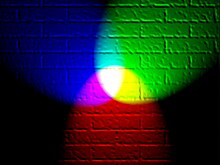RGB color model
The RGB color model is an additive color model. In this model red, green and blue are added together to form a new color.
An RGB color can be made by shining three colored lights of red, green, and blue onto a white wall in a dark room. Each light has a dimmer (to regulate its intensity.)

If only the red light is on, the wall will be red. If only the green light is on, the wall will look green. If the red and green lights are on together, the wall will look yellow. Dim the red light and the wall will become more of a yellow-green.
Each setting of the three dimmers will produce a different result, either in color or in brightness or both. The set of all possible results is the gamut. Swap the red lamp for one of a different brand that is slightly more orange, and there will be a slightly different gamut, since the set of all colors that can be produced with the three lights will be changed.
Details
changeThe name of the model comes from the initials of the three primary colors, red, green, and blue.
The purpose of the RGB color model is for capturing, storing, and displaying images in digital electronic devices, such as photo cameras, television sets, video cameras and computers. Before the electronic age, the RGB color model already had a solid theory behind it, based in human perception of colors.
The RGB color model is an additive color model in which red, green, and blue light are added together in various ways to reproduce a broad set of colors. The three light beams are added together, and their light spectra add to make the final color's spectrum.[1][2] Zero intensity for each component gives the darkest color (no light, considered the black), and full intensity of each gives a white. This is in stark contrast to physical paints, such as oil paint, which create black when mixed.
The additive color model is opposite to the subtractive color model, particularly the CMY color model.
History
changeThe RGB color model is based on the Young–Helmholtz theory of trichromatic color vision, developed by Thomas Young and Hermann von Helmholtz in the early to mid-nineteenth century, and on James Clerk Maxwell's color triangle that elaborated that theory (circa 1860).
The first experiments with RGB in early color photography were made in 1861 by Maxwell himself, and involved the process of combining three color-filtered separate picture takes.[3] To reproduce the color photograph, three matching projections over a screen in a dark room were necessary.
The modern RGB technology for color CRT displays was patented by Werner Flechsig in Germany in 1938.[4]
Numeric values
changeA color in the RGB color model is recorded by indicating how much of each of the red, green, and blue is included. The color is expressed as an RGB triplet (r,g,b), each component of which can vary from zero to a defined maximum value. If all the components are at zero the result is black; if all are at maximum, the result is the brightest representable white.
These ranges may be quantified in several different ways:
- From 0 to 1, with any fractional value in between. This representation is used in theoretical analyses, and in systems that use floating point representations.
- Each color component value can also be written as a percentage, from 0% to 100%.
- In computers, the component values are often stored as integer numbers in the range 0 to 255, the range that a single 8-bit byte can offer. These are often represented as either decimal or hexadecimal numbers.
- Sophisticated digital image equipment are often able to deal with larger integer ranges for each primary color, such as 0..1023 (10 bits), 0..65535 (16 bits) or even larger, by extending the 24-bits (three 8-bit values) to 32-bit, 48-bit, or 64-bit units.
For example, brightest saturated red is written in the different RGB notations as:
Notation RGB triplet Arithmetic (1.0, 0.0, 0.0) Percentage (100%, 0%, 0%) Digital 8-bit per channel (255, 0, 0) or sometimes
#FF0000 (hexadecimal)Digital 12-bit per channel (4095, 0, 0) Digital 16-bit per channel (65535, 0, 0)
Related pages
changeReferences
change- ↑ Charles A. Poynton (2003). Digital Video and HDTV: Algorithms and Interfaces. Morgan Kaufmann. ISBN 1-55860-792-7.
- ↑ Nicholas Boughen (2003). Lightwave 3d 7.5 Lighting. Wordware Publishing, Inc. ISBN 1-55622-354-4.
- ↑ Robert Hirsch (2004). Exploring Colour Photography: A Complete Guide. Laurence King Publishing. ISBN 1-85669-420-8.
- ↑ Morton, David L. (1999). "Television Broadcasting". A History of Electronic Entertainment Since 1945 (PDF). IEEE. ISBN 0-7803-9936-6. Archived from the original (PDF) on March 6, 2009.